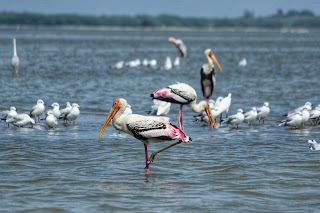Auroville, near Pondicherry, is a unique experimental township founded in 1968 by The Mother( Mirra Alfassa) based on the vision of her guru Sri Aurobindo. It is a unique international cultural community focused on realizing human unity in diversity and transforming consciousness. The city, designed by Roger Anger a French architect, is organized into four zones (Residential, Cultural, International, and Industrial) with the Matrimandir at the centre.
During our recent trip to Pondicherry we took a guided tour within the sprawling 4500 acre Auroville. The tour highlighted the diverse aspects, including its residential communities, cultural and educational centers, and industrial units. The township is focused on sustainable practices - having an independent internet station, waste to fertilizer units, solar towers, water tanks using rainwater and borewells, farms, bakery and dairy farm for their daily use and even a brick manufacturing unit used for their constructions.
 |
| A residential house |
The Residential Zone is designed for living, rejuvenation, and fostering community life. It features various residential communities with apartments and individual houses. This zone is home to around 4,000 permanent residents from 59 countries as of today. The interesting fact is there's no cash transaction within and each resident is given an aura card loaded with an equal amount to be spent monthly. The buildings utilize locally made bricks and have incorporated solar panels.
 |
| Solar kitchen |
Essential services like the Solar Kitchen- a community kitchen which serves lunch, Pour Tous Distribution - a distribution unit which supplies food products and ready to eat meals on pay what you can basis, the Santé Institute - a healthcare center, Mahalakshmi Senior's Home, and the main library are located here for the benifit of the residents.
 |
| Healthcare center |
Cultural Zone: includes educational institutions like Future School- high school with IB curriculum, Transition School - primary & middle school, the Youth Center and Sports grounds. This zone also features the well known Kalabhumi music studio which is a music rehearsal space with amphitheatre and has an array of instruments where Aurovillians practice, teach and collaborate.
 |
| Products of Auroville |
The key buildings in Auroville's International Zone are Bharat Nivas, Savitri Bhavan, and the Unity Pavilion, which are all important centers for cultural exchange, education, and events. Bharat Nivas houses the Kalakendra Art Exhibition Hall and Sri Aurobindo Auditorium, while Savitri Bhavan - serves as a hub for studying Sri Aurobindo's teachings. The Unity Pavilion is notable for its Peace tables where meditation to inculcate the importance of peace is conducted around this table on a weekly basis.
The Industrial Zone includes the Auroville Earth Institute - an organisation promoting earth technology for low cost, low energy buildings. The Center for Scientific Research (CSR)- an international voluntary organisation working towards renewable energy and a number of small-scale manufacturing units such as Shraddhanjali, which manufactures artistic utility items, and Colours of Nature – a natural fabric dyeing unit.
 |
| Spirulina production unit |
Our tour guide halted at the spirulina production unit where the volunteers served a refreshing drink of its paste and highlighted the importance of this superfood.
 |
| The drink served |
The one-hour tour in the minivan was brief to absorb the expanse of this self sustaining land but the insight into Mother's futuristic vision left us awe-inspiring.
 |
| Senior's home |
 |
| Distribution unit |
Note - Auroville township has received endorsements from UNESCO through resolutions passed in 1966, 1968, 1970, and 1983. Since 1980, the Ministry of Education oversees the township, which is governed by the Auroville Foundation Act of 1988 passed by the Indian Parliament. This act formalized the foundation's structure and aims to facilitate Auroville's development in accordance with its founding charter.




























